AMPK Causes Cell Cycle Arrest in LKB1-Deficient Cells via Activation of CAMKK2
- PMID: 27141100
- PMCID: PMC5390849
- DOI: 10.1158/1541-7786.MCR-15-0479
AMPK Causes Cell Cycle Arrest in LKB1-Deficient Cells via Activation of CAMKK2
Erratum in
-
Editor's Note: AMPK Causes Cell Cycle Arrest in LKB1-Deficient Cells via Activation of CAMKK2.Mol Cancer Res. 2025 May 2;23(5):477. doi: 10.1158/1541-7786.MCR-25-0265. Mol Cancer Res. 2025. PMID: 40313094 No abstract available.
Abstract
The AMP-activated protein kinase (AMPK) is activated by phosphorylation at Thr172, either by the tumor suppressor kinase LKB1 or by an alternate pathway involving the Ca(2+)/calmodulin-dependent kinase, CAMKK2. Increases in AMP:ATP and ADP:ATP ratios, signifying energy deficit, promote allosteric activation and net Thr172 phosphorylation mediated by LKB1, so that the LKB1-AMPK pathway acts as an energy sensor. Many tumor cells carry loss-of-function mutations in the STK11 gene encoding LKB1, but LKB1 reexpression in these cells causes cell-cycle arrest. Therefore, it was investigated as to whether arrest by LKB1 is caused by activation of AMPK or of one of the AMPK-related kinases, which are also dependent on LKB1 but are not activated by CAMKK2. In three LKB1-null tumor cell lines, treatment with the Ca(2+) ionophore A23187 caused a G1 arrest that correlated with AMPK activation and Thr172 phosphorylation. In G361 cells, expression of a truncated, Ca(2+)/calmodulin-independent CAMKK2 mutant also caused G1 arrest similar to that caused by expression of LKB1, while expression of a dominant-negative AMPK mutant, or a double knockout of both AMPK-α subunits, also prevented the cell-cycle arrest caused by A23187. These mechanistic findings confirm that AMPK activation triggers cell-cycle arrest, and also suggest that the rapid proliferation of LKB1-null tumor cells is due to lack of the restraining influence of AMPK. However, cell-cycle arrest can be restored by reexpressing LKB1 or a constitutively active CAMKK2, or by pharmacologic agents that increase intracellular Ca(2+) and thus activate endogenous CAMKK2.
Implications: Evidence here reveals that the rapid growth and proliferation of cancer cells lacking the tumor suppressor LKB1 is due to reduced activity of AMPK, and suggests a therapeutic approach by which this block might be circumvented. Mol Cancer Res; 14(8); 683-95. ©2016 AACR.
©2016 American Association for Cancer Research.
Conflict of interest statement
The authors have no conflicts of interest to declare.
Figures

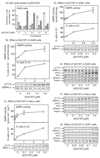
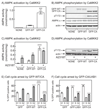
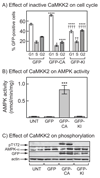
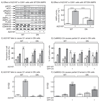
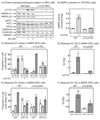
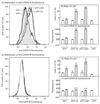
Similar articles
-
Concurrent regulation of LKB1 and CaMKK2 in the activation of AMPK in castrate-resistant prostate cancer by a well-defined polyherbal mixture with anticancer properties.BMC Complement Altern Med. 2018 Jun 18;18(1):188. doi: 10.1186/s12906-018-2255-0. BMC Complement Altern Med. 2018. PMID: 29914450 Free PMC article.
-
Genotoxic Damage Activates the AMPK-α1 Isoform in the Nucleus via Ca2+/CaMKK2 Signaling to Enhance Tumor Cell Survival.Mol Cancer Res. 2018 Feb;16(2):345-357. doi: 10.1158/1541-7786.MCR-17-0323. Epub 2017 Nov 13. Mol Cancer Res. 2018. PMID: 29133590
-
eNOS activation mediated by AMPK after stimulation of endothelial cells with histamine or thrombin is dependent on LKB1.Biochim Biophys Acta. 2011 Feb;1813(2):322-31. doi: 10.1016/j.bbamcr.2010.12.001. Epub 2010 Dec 9. Biochim Biophys Acta. 2011. PMID: 21145922
-
Spatial control of AMPK signaling at subcellular compartments.Crit Rev Biochem Mol Biol. 2020 Feb;55(1):17-32. doi: 10.1080/10409238.2020.1727840. Epub 2020 Feb 18. Crit Rev Biochem Mol Biol. 2020. PMID: 32069425 Free PMC article. Review.
-
AMP-activated protein kinase in metabolic control and insulin signaling.Circ Res. 2007 Feb 16;100(3):328-41. doi: 10.1161/01.RES.0000256090.42690.05. Circ Res. 2007. PMID: 17307971 Review.
Cited by
-
Knockdown of LKB1 Sensitizes Endometrial Cancer Cells via AMPK Activation.Biomol Ther (Seoul). 2021 Nov 1;29(6):650-657. doi: 10.4062/biomolther.2021.131. Biomol Ther (Seoul). 2021. PMID: 34607979 Free PMC article.
-
Sequential activation of ERα-AMPKα signaling by the flavonoid baicalin down-regulates viral HNF-dependent HBV replication.Acta Pharmacol Sin. 2025 Mar;46(3):653-661. doi: 10.1038/s41401-024-01408-3. Epub 2024 Oct 30. Acta Pharmacol Sin. 2025. PMID: 39478159 Free PMC article.
-
STIM2 interacts with AMPK and regulates calcium-induced AMPK activation.FASEB J. 2019 Feb;33(2):2957-2970. doi: 10.1096/fj.201801225R. Epub 2018 Oct 18. FASEB J. 2019. PMID: 30335546 Free PMC article.
-
As a New Tumor Suppressor Gene, PID1 Activates the AMPK-mTOR Signal to Inhibit the Progression of Bladder Cancer.Res Rep Urol. 2025 Jul 24;17:235-248. doi: 10.2147/RRU.S530209. eCollection 2025. Res Rep Urol. 2025. PMID: 40727235 Free PMC article.
-
Attenuation of Lipopolysaccharide-Induced Acute Lung Injury by Hispolon in Mice, Through Regulating the TLR4/PI3K/Akt/mTOR and Keap1/Nrf2/HO-1 Pathways, and Suppressing Oxidative Stress-Mediated ER Stress-Induced Apoptosis and Autophagy.Nutrients. 2020 Jun 10;12(6):1742. doi: 10.3390/nu12061742. Nutrients. 2020. PMID: 32532087 Free PMC article.
References
-
- Hardie DG. AMPK: positive and negative regulation, and its role in whole-body energy homeostasis. Curr Opin Cell Biol. 2014;33C:1–7. - PubMed
-
- Hawley SA, Davison M, Woods A, Davies SP, Beri RK, Carling D, et al. Characterization of the AMP-activated protein kinase kinase from rat liver, and identification of threonine-172 as the major site at which it phosphorylates and activates AMP-activated protein kinase. J Biol Chem. 1996;271:27879–87. - PubMed
MeSH terms
Substances
Grants and funding
LinkOut - more resources
Full Text Sources
Other Literature Sources
Research Materials
Miscellaneous

